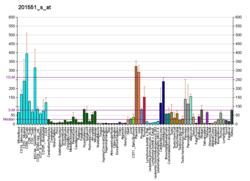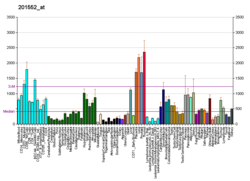LAMP1
Protein-coding gene in the species Homo sapiens From Wikipedia, the free encyclopedia
Lysosomal-associated membrane protein 1 (LAMP-1) also known as lysosome-associated membrane glycoprotein 1 and CD107a (Cluster of Differentiation 107a), is a protein that in humans is encoded by the LAMP1 gene. The human LAMP1 gene is located on the long arm (q) of chromosome 13 at region 3, band 4 (13q34).

Lysosomal-associated membrane protein 1 is a glycoprotein from a family of Lysosome-associated membrane glycoproteins.[5] The LAMP-1 glycoprotein is a type I transmembrane protein[6] which is expressed at high or medium levels in at least 76 different normal tissue cell types.[7] It resides primarily across lysosomal membranes,[8] and functions to provide selectins with carbohydrate ligands.[5] CD107a has also been shown to be a marker of degranulation on lymphocytes such as CD8+ and NK cells,[9] and may also play a role in tumor cell differentiation and metastasis.
Structure
Residing primarily across lysosomal membranes, these glycoproteins consist of a large, highly glycosylated end with N-linked carbon chains on the luminal side of the membrane, and a short C-terminal tail[6] exposed to the cytoplasm.[8] The extracytoplasmic region contains a hinge-like structure which can form disulphide bridges homologous to those observed in human immunoglobulin A.[8] Other characteristics of the structure of the LAMP-1 glycoproteins include:
- A polypeptide core of ~40kDa[8]
- 18 {N-glycosylation} sites to help with the addition of sugar chains[10]
- Polylactosamine attachments which protect the glyocoprotein from degradation by lysosomal proteases[10]
- Significant quantities of polylactosaminoglycan and sialic acid to traverse the trans-Golgi cisternae.[10]
- poly-N-acetyllactosamine groups which are involved in interactions with selectin and other glycan-binding proteins[11]
Function
Summarize
Perspective
LAMP1 and LAMP2 glycoproteins comprise 50% of all lysosomal membrane proteins,[6] and are thought to be responsible in part for maintaining lysosomal integrity, pH and catabolism.[6][11] The expression of LAMP1 and LAMP2 glycoproteins are linked, as deficiencies in LAMP1 gene will lead to increased expression of LAMP2 glycoproteins.[11] The two are therefore thought to share similar functions in vivo.[6] However, this makes the determining the precise function of LAMP1 difficult, because while the LAMP1 deficient phenotype is little different than the wild type due to LAMP2 up regulation,[6][11] the LAMP1/LAMP2 double deficient phenotype leads to embryonic lethality.[11]
Although the LAMP1 glycoproteins primarily reside across lysosomal membranes, in certain cases they can be expressed across the plasma membrane of the cell.[11] Expression of LAMP1 at the cell surface can occur due to lysosomal fusion with the cell membrane.[12] Cell surface expression of LAMP1 can serve as a ligand for selectins[13][14] and help mediate cell-cell adhesion.[15] Accordingly, cell surface expression of LAMP1 is seen in cells with migratory or invasive functions, such as cytotoxic T cells, platelets and macrophages.[16] Cell surface expression of LAMP1 and LAMP2 is also often seen in cancer cells,[16][17] particularly cancers with high metastatic potential, such as colon carcinoma and melanoma,[16] and has been shown to correlate with their metastatic potential.[11]
Role in cancer
LAMP1 expression on the surface of tumor cells has been observed for a number of different cancer types, particularly in highly metastatic cancers such as pancreatic cancer,[18][19] colon cancer[16][17] and melanoma.[16][17] The structure of LAMP1 correlates with differentiation[8][20] and metastatic potential[11] of tumor cells as it is thought to help mediate cell-cell adhesion [17] and migration.[15][18] Indeed, the adhesion of some cancer cells to the extracellular matrix is mediated by interactions between LAMP1 and LAMP2 and E-selectin and galectins, with the LAMPs serving as ligands for the cell-adhesion molecules.[17]
Cell membrane expression of LAMP-1 observed in the following cancer types:
See also
References
Further reading
External links
Wikiwand - on
Seamless Wikipedia browsing. On steroids.







